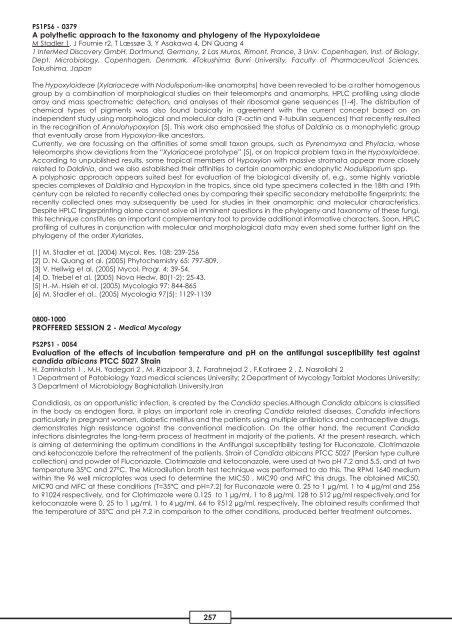Handbook Part 2 - International Mycological Association
Handbook Part 2 - International Mycological Association
Handbook Part 2 - International Mycological Association
You also want an ePaper? Increase the reach of your titles
YUMPU automatically turns print PDFs into web optimized ePapers that Google loves.
PS1PS6 - 0379<br />
A polythetic approach to the taxonomy and phylogeny of the Hypoxyloideae<br />
M Stadler 1, J Fournie r2, T Læssøe 3, Y Asakawa 4, DN Quang 4<br />
1 InterMed Discovery GmbH, Dortmund, Germany, 2 Las Muros, Rimont, France, 3 Univ. Copenhagen, Inst. of Biology,<br />
Dept. Microbiology, Copenhagen, Denmark, 4Tokushima Bunri University, Faculty of Pharmaceutical Sciences,<br />
Tokushima, Japan<br />
The Hypoxyloideae (Xylariaceae with Nodulisporium-like anamorphs) have been revealed to be a rather homogenous<br />
group by a combination of morphological studies on their teleomorphs and anamorphs, HPLC profiling using diode<br />
array and mass spectrometric detection, and analyses of their ribosomal gene sequences [1-4]. The distribution of<br />
chemical types of pigments was also found basically in agreement with the current concept based on an<br />
independent study using morphological and molecular data (?-actin and ?-tubulin sequences) that recently resulted<br />
in the recognition of Annulohypoxylon [5]. This work also emphasised the status of Daldinia as a monophyletic group<br />
that eventually arose from Hypoxylon-like ancestors.<br />
Currently, we are focussing on the affinities of some small taxon groups, such as Pyrenomyxa and Phylacia, whose<br />
teleomorphs show deviations from the “Xylariaceae prototype” [5], or on tropical problem taxa in the Hypoxyloideae.<br />
According to unpublished results, some tropical members of Hypoxylon with massive stromata appear more closely<br />
related to Daldinia, and we also established their affinities to certain anamorphic endophytic Nodulisporium spp.<br />
A polyphasic approach appears suited best for evaluation of the biological diversity of, e.g., some highly variable<br />
species complexes of Daldinia and Hypoxylon in the tropics, since old type specimens collected in the 18th and 19th<br />
century can be related to recently collected ones by comparing their specific secondary metabolite fingerprints; the<br />
recently collected ones may subsequently be used for studies in their anamorphic and molecular characteristics.<br />
Despite HPLC fingerprinting alone cannot solve all imminent questions in the phylogeny and taxonomy of these fungi,<br />
this technique constitutes an important complementary tool to provide additional informative characters. Soon, HPLC<br />
profiling of cultures in conjunction with molecular and morphological data may even shed some further light on the<br />
phylogeny of the order Xylariales.<br />
[1] M. Stadler et al. (2004) Mycol. Res. 108: 239-256<br />
[2] D. N. Quang et al. (2005) Phytochemistry 65: 797-809.<br />
[3] V. Hellwig et al. (2005) Mycol. Progr. 4: 39-54.<br />
[4] D. Triebel et al. (2005) Nova Hedw. 80(1-2): 25-43.<br />
[5] H.-M. Hsieh et al. (2005) Mycologia 97: 844-865<br />
[6] M. Stadler et al.. (2005) Mycologia 97(5): 1129-1139<br />
0800-1000<br />
PROFFERED SESSION 2 - Medical Mycology<br />
PS2PS1 - 0054<br />
Evaluation of the effects of incubation temperature and pH on the antifungal susceptibility test against<br />
candida albicans PTCC 5027 Strain<br />
H. Zarrinkafsh 1 , M.H. Yadegari 2 , M. Riazipoor 3, Z. Farahnejad 2 , F.Katiraee 2 , Z. Nasrollahi 2<br />
1 Department of Patobiology Yazd medical sciences University; 2 Department of Mycology Tarbiat Modares University;<br />
3 Department of Microbiology Baghiatallah University,Iran<br />
Candidiasis, as an opportunistic infection, is created by the Candida species.Although Candida albicans is classified<br />
in the body as endogen flora, it plays an important role in creating Candida related diseases. Candida infections<br />
particularly in pregnant women, diabetic mellitus and the patients using multiple antibiotics and contraceptive drugs,<br />
demonstrates high resistance against the conventional medication. On the other hand, the recurrent Candida<br />
infections disintegrates the long-term process of treatment in majority of the patients. At the present research, which<br />
is aiming at determining the optimum conditions in the Antifungal susceptibility testing for Fluconazole, Clotrimazole<br />
and ketoconazole before the retreatment of the patients. Strain of Candida albicans PTCC 5027 (Persian type culture<br />
collection) and powder of Fluconazole, Clotrimazole and ketoconazole, were used at two pH 7.2 and 5.5, and at two<br />
temperature 35ºC and 27ºC. The Microdilution broth test technique was performed to do this. The RPMI 1640 medium<br />
within the 96 well microplates was used to determine the MIC50 , MIC90 and MFC this drugs. The obtained MIC50,<br />
MIC90 and MFC at these conditions (T=35ºC and pH=7.2) for Fluconazole were 0. 25 to 1 µg/ml, 1 to 4 µg/ml and 256<br />
to ?1024 respectively, and for Clotrimazole were 0.125 to 1 µg/ml, 1 to 8 µg/ml, 128 to 512 µg/ml respectively,and for<br />
ketoconazole were 0. 25 to 1 µg/ml, 1 to 4 µg/ml, 64 to ?512 µg/ml, respectively. The obtained results confirmed that<br />
the temperature of 35ºC and pH 7.2 in comparison to the other conditions, produced better treatment outcomes.<br />
257









